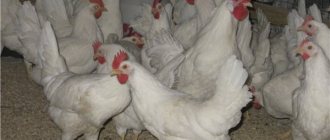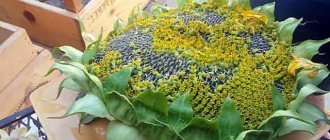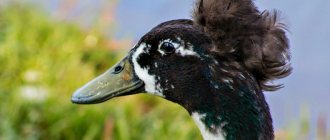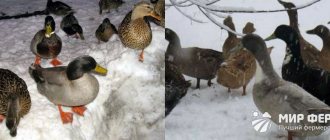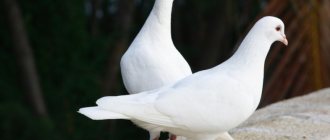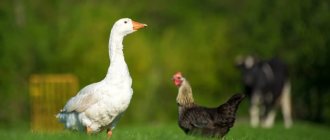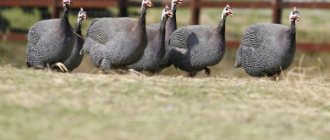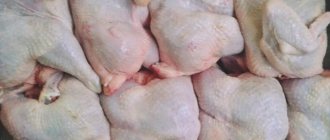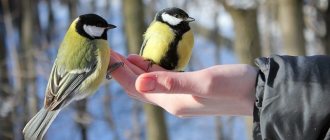Home » Articles about guinea fowl » Breeds of guinea fowl
Wild guinea fowl are inferior in productivity to artificially bred meat and egg breeds. Despite the limited number of the latter, you can choose the best option taking into account the desired characteristics.
Care and maintenance
Siberian guinea fowl are considered unpretentious birds. They can survive in almost any conditions. They have a calm disposition, are hardy and viable. Birds are not afraid of cold weather and temperature changes, are unpretentious in their diet, and can live on paddocks, indoors or even in cages. These and other qualities make the breed valuable to farmers.
Premises requirements
Any room is suitable for raising Siberian guinea fowl. In the summer, an ordinary barn can become a home for birds, and for year-round winter maintenance you cannot do without a well-insulated chicken coop, where all the required conditions will be met:
- In order for the birds to survive the winter well, it is necessary to arrange a deep litter in the poultry house using hay, sawdust, peat or shavings.
- Install perches in the poultry house at a height of 50-70 cm from the floor. One guinea fowl accounts for 25-30 cm of perch length.
- Birds usually choose secluded places to lay eggs, so installing nests is a futile task.
- In the poultry house, it is necessary to equip a hole measuring 30x30 cm. It must open outward so that the animal can freely get out, and the farmer, when opening the door, does not accidentally injure the animals.
Walking yard
Siberian birds feel great in closed poultry houses and cages, but providing a walk for the birds will allow the birds to eat pasture, which will significantly reduce the cost of feeding the animals. Guinea fowl like to feast on Colorado beetles, locusts, caterpillars, weevils, butterflies and other malicious field pests, even small rodents. At the same time, birds do not rake the garden, causing damage to the roots of plants.
It is necessary to build an aviary next to the poultry house, fencing the area with a mesh at least 2 meters high. Birds fly well, and the net will not give them the opportunity to escape to freedom. The area of the enclosure depends on the purpose for which the farmer keeps guinea fowl. To obtain a high-quality fertilized egg, each individual requires at least 15 square meters of territory.
Feeding and regimen
Siberian white guinea fowl are also not demanding on their diet. They are able to feed on any plant or animal food. When creating a diet for birds of this breed, it is necessary to follow the same recommendations as for egg-laying chickens.
The specific composition and volume of feed depends on the conditions of keeping the poultry, including whether it has the opportunity to go out for a walk or is kept indoors. If a bird grazes in the fresh air all day, it will independently obtain the bulk of its green food and protein-containing products (various insects). In this case, you will need to feed her only once a day, in the evening.
It is recommended to use various dry grain mixtures or wet mash as feed. Some breeders prefer to save time, so they feed guinea fowls with high-quality compound feed. In addition to food, birds must always have access to clean and fresh water - warm liquid is added to the drinking bowls.
In the absence of walking, guinea fowls need to be provided with a complete and balanced diet. The main components of the food are fresh greens and various insects. In addition, the menu should contain vegetables, combined feed and food waste. Last but not least are mineral supplements. It is advisable to give birds crushed shells, river sand, chalk, and fine gravel. These products will not only supply the body with calcium and beneficial minerals, but also improve the functioning of the digestive system.
For a guinea fowl to gain 1 kilogram of live weight, it needs 3-3.3 kg of feed. The various feeds in the diet are distributed approximately according to the system proposed in the table:
| Type of feed | Percentage in diet | Amount of feed per individual per year |
| Mineral supplements | 4% | 2 kg |
| Green grass | 20% | 10-12 kg |
| Root vegetables and other vegetables | 9% | 4-5 kg |
| Food of animal origin | 7% | 3-4 kg |
| Grain and feed | 60% | 30-35 kg |
Character and lifestyle
Siberian guinea fowl are non-conflict animals. Most breeders note the positive quality of Siberian guinea fowls - a calm and balanced disposition. These birds are able to get along with other breeds and establish contact with all the inhabitants of the house.
Farmers note the main drawback of the bird - its excessive timidity. Guinea fowl often react to extraneous noises and strangers - they begin to scream and behave hysterically. Animals take a long time to get used to a new place, react poorly to any changes in living conditions, and do not like change.
The Siberian guinea fowl can hardly be called tame. If you try to pick her up, the guinea fowl turns from a calm animal into an aggressive beast: it begins to struggle, angrily hiss and even scratch. If the owner tries to hold the bird by the feathers, it will not spare itself and will try to escape at any cost. This character trait can negatively affect the hatching of eggs, which is why experienced breeders tend to use an incubator or laying hens for these purposes.
Breed advantages and disadvantages
Speaking about the advantages, it is worth noting first of all the attractive presentation of the carcass. The bird quickly gains weight, is unpretentious in maintenance, eats any feed, which allows you to obtain meat that is soft and good in taste at minimal cost.
If we talk about disadvantages, then there is a comparatively low egg production and difficulty in determining sex. If you are a novice poultry farmer, then before purchasing a bird we recommend collecting as much material and information about them as possible. You can learn a lot from the articles collected on our website.
It is important to decide on the breed and direction of breeding, namely what you will breed birds for: for meat, for eggs, or just for beauty. Many experienced poultry farmers recommend starting the breeding of royal birds not by purchasing adult birds, but by purchasing chickens
They are not expensive, and the difference in price between different breeds is insignificant, but preference should be given to those breeds that are better adapted to our climatic conditions.
One of these breeds is the Volga white guinea fowl, which was bred from the Siberian white (and they, in turn, were bred from the grey-speckled ones) by Omsk specialists. To obtain this, individuals were selected that were distinguished not only by their white feather color, but also by their high productivity.
It is worth knowing that in order to obtain this breed it took many years and the greatest successes were achieved by Stavropol specialists and it was from these places that the breed began to spread to other regions.
According to available information, approximately 20 thousand individuals are kept at enterprises in our country.
History of the origin of the breed
The breed was bred by Siberian breeders in Omsk. It received official registration in 1978. Scientists were faced with the task of increasing egg production and obtaining light skin. The carcasses of wild guinea fowl looked unpleasant due to their red meat and thin translucent skin. It was not customary to eat poultry.
Scientists chose wild individuals for crossing, which had white skin from a natural mutation. Over many years of painstaking work, breeders managed to achieve a positive result. During breeding, the bred breed retained the ability to inherit white-cream skin to its offspring. The egg production rate has increased noticeably.
How to select healthy adults when purchasing
What should beginners do to properly breed guinea fowl? First of all, it is necessary to select the right individuals so that there are no problems with their cultivation in the future. It should be clarified that only domestic gray guinea fowl are suitable for breeding at home, despite the fact that there are 25 species of them in nature.
It is necessary to purchase individuals from a specialized poultry farm, which will guarantee the origin, health and productivity of the bird. When purchasing, be sure to ask for and carefully read the veterinary certificate, which will contain the necessary information about the purchased product.
Individuals from one day of age are suitable for purchasing guinea fowl. It is during this period that transportation will be less painful for the bird. If you buy older guinea fowl, you will need special containers during transportation. Sometimes, if transportation is long, the birds are provided with food and water. But despite the difficulties with transportation, such a bird will be easier and faster to raise.
Adults are not recommended for purchase.
Important! When purchasing, it is necessary to take into account that a small group of birds will be worse preserved and develop more slowly, so it is recommended to purchase at least 20 birds at once.
In order to choose good healthy guinea fowls, you need to pay attention to the following features:
The bird must be well-fed, not lame, have no body defects, and have a typical coloration. You should not purchase birds that have signs of rickets, for example, curvature in the breastbone or wings, emaciated individuals that have poor coordination of movement, as well as a swollen belly. At 5 months of age (during this period it is certainly possible to determine the sex of a guinea fowl), the average weight of the bird should be: for females - at least 1.3 kg, for males - 1.4 kg. The bird should have protruding, shiny, mobile eyes
Pay attention to the pupil - it should not be reduced and slit-like.
To figure out how to distinguish guinea fowl, namely a male from a female, you should take into account the following features:
- Birds at 5 months of age differ in the size and shape of their head appendages. Females have a small and flat cere, which practically does not rise above the beak. Males have a larger and arched cere, which rises above the beak and has a brighter color than that of females.
- On the head of males there is a large, vertically located crest, while in females, on the contrary, the crest is small and directed backwards.
- Males also have lateral earrings, which are sometimes curled and larger in size than those of females.
Important! When selecting males, it should be taken into account that for 1 male you need to purchase 4-5 females, and there should be no less than 2-3 males in the group.
External signs
By the name it is already easy to judge the appearance of the Siberian guinea fowl. The bird's body is covered with pure white plumage. The color is not shiny, but slightly matte. Spots of bright white are visible throughout the plumage. They resemble the discolored pattern of a grey-speckled guinea fowl.
Important! The Siberian guinea fowl retains its lush plumage all summer.
Other external signs:
- The small head is covered with rough skin. On the top of the head there is a horn-shaped growth of dull pink color. The earrings are fleshy, bright pink in males, and pale in females. A small beard hangs under the beak.
- The beak is short but powerful. The tip is slightly bent down. The color of the beak is gray-yellow, sometimes pinkish.
- The neck is elongated, the plumage in this area is sparse.
- The physique is large. The length of the body reaches 50 cm. The back and tail form a single plane. The chest is wide, in females it is larger.
- The paws are short but thick. The skin is pink.
- The short tail ends with downward-curved feathers.
- Wings of medium size. The ends of the outer flight feathers are adjacent to the base of the tail when the bird presses them tightly to the body.
It is easier to distinguish a female from a male by its shorter neck length, but enlarged muscular chest.
Nutrition of adult guinea fowl
Guinea fowl are fed at home with the same products that are suitable for feeding chickens, turkeys and other farm poultry. The basis of the menu is grain - 70% of the total weight of food, vegetables and herbs occupy 20-23%, the remaining 7-10% comes from animal protein (milk, meat, fish, cakes, yeast).
In summer
When the weather permits, the individuals go out for a walk and eat a lot of greens, which significantly reduces the cost of keeping them for the poultry farmer. In the summer, it is enough to feed each adult bird about 100 g of grain; the rest will be found on its own in grazing.
Guinea fowl are released for grazing when the daytime temperature does not drop below +15 degrees. It is preferable to graze livestock on dry meadows overgrown with cereals and legumes. Grazing in low-lying wetlands should be avoided. In such places there is a risk that the bird will become infected with worms.
The diet of an adult bird includes whole and crushed (chopped) or rolled grains of corn, wheat, barley, and oats. The ratio of crops in the grain mixture is 1:2:1:2, respectively. Grain is poured into feeders in dry form or given in a crumbly mash.
in winter
Guinea fowl are a heat-loving species that do not tolerate frost well. In winter, the livestock is kept in closed, insulated rooms, released for walking only when it thaws. To prevent the bird from suffering from the lack of sun and fresh herbs, its diet includes fresh vegetables and herbal meal.
Livestock can be given carrots, pumpkin, white cabbage, and fodder beets. Fresh vegetables are given in the form of large pieces. The bird itself will peck out the tasty parts, leaving the skin intact.
Oats, barley and wheat are sprouted for the livestock. The grain, washed from dust and debris, is scattered in a 1 cm layer onto pallets and covered with a wet cloth. At a temperature of 22–24 degrees, sprouts on the grain will appear in 18–26 hours. The product is fed to adult guinea fowls, 5–8 g of each individual per day.
Grass meal is an indispensable source of vitamins for poultry during the winter. It can be purchased at stores that sell pet food. Grass meal is sold in granules, which are soaked in warm water before feeding. Flour is made from the hay of legumes - alfalfa, sainfoin, clover.
At home, you can make flour from ordinary dried grass. To do this, take plants with broad foliage - nettle, quinoa. They are dried, collected in bunches, and then crushed, rubbed with hands in thick mittens. Herbal flour is stored in paper bags in a dry and dark place. It is given to guinea fowls 10–15 g per day, added to mash.
Sprouted grain
Herbal granules
Suede or cream
The breed appeared as a consequence of the mutation process of the gray guinea fowl. In appearance it resembles the White Siberian, but is distinguished by its smaller size and blue skin. The feathers are mostly white, although pigment spots are present. The birds are assigned to a newly introduced breed, which is why they are still poorly adapted. Egg production is low and ranges from 70 to 80 eggs per year, the weight of which fluctuates around 45 grams. A mature female individual reaches a mass of about 1.7 kg, and a male one is slightly smaller.
White Siberian guinea fowl
The birds are hardy to home conditions and unpretentious. An egg-oriented breed. White guinea fowl are adapted to life in cold regions of the country and easily tolerate unfavorable and harsh climates.
Has the following characteristics:
- deep gray beak;
- metatarsus pale pink;
- whitish matte plumage, which is a distinctive feature of the breed;
- small head;
- voluminous earrings;
- lack of feathers on the neck.
An adult male weighs 1.6-1.8 kg, and a female weighs 2 kg. One bird can produce 100-110 eggs per year. Siberian whites easily adapt to frost and quickly gain weight. They have a calm and friendly character. The peculiarity of the breed is the light color of the carcass, since in other varieties it has a bluish tint. Guinea fowl can survive in any conditions. They get along well with other inhabitants of the poultry yard. They are unpretentious in nutrition and can live on walks, in cages and indoors.
Productive qualities
The Siberian white guinea fowl has good productive performance. It is especially famous for its high egg production, because it is more than 25% larger than the number of laid eggs of other breeds that are bred in our country. Birds not only grow quickly, but also gain weight rapidly.
One female lays about 80-90, sometimes 100 eggs weighing 50 grams per year. The fertilization rate of eggs is 75-90%. The weak point of the breed is the high mortality rate among chicks, it reaches up to 47%.
The weight of an adult bird varies within 2 kilograms. At 2.5 months, a young guinea fowl weighs about 900 grams. During this time, she feeds on food, consuming a little more than 3 kilos.
The Siberian guinea fowl has tasty, nutritious and tender meat. A guinea fowl carcass contains 10-15% more meat than a chicken carcass. Guinea fowl meat contains a minimum of fat and a maximum of iron, the deficiency of which reduces the level of hemoglobin in the blood.
Feeding the young
Feeding diet for young guinea fowl depending on age:
| Type of feed | Age (days) | |||
| 1-20 | 21-40 | 41-60 | 61-80 | |
| Crushed shell or sand | 0.25 g | 0.5 g | 1 g | 1.5 g |
| Bran | 1 g | 10 g | 18 g | 25 g |
| Yeast | 0.2 g | 0.5 g | 1 g | 1.5 g |
| Oats | 1 g | 7 g | 5 g | 5 g |
| Greenery | 3 g | 8 g | 20 g | 20 g |
| Barley | 1.5 g | 8 g | 12 g | 5 g |
| Return | 5 g | 7.5 g | — | — |
| Millet | 2 g | 5 g | 7 g | — |
| Fresh cottage cheese | 1 g | 5 g | 5 g | 2.5 g |
| Meat and bone meal | 0.5 g | 1 g | 2 g | 3 g |
| Wheat flour | 4.5 g | 7 g | 10 g | 20 g |
In the period from 1 to 10 days, the chicks can also be fed with a mixture of boiled eggs with skimmed milk or cottage cheese. A mixture of greens and boiled yolk is also good.
Starting from day 80, guinea fowl can be switched to adult food.
You can also use chicken feed for chickens of the appropriate age. The physiology of guinea fowl differs little from that of chickens, and therefore starter feed for feeding chickens is perfect.
- Stern
- Recipes
- Supplements
Compound feed for broilers PC 5 Start, PC 5 Growth, PC 5 Finish 1
Characteristics, feeding standards, consumer reviews Read
Complete feed for laying hens PK 1-1 and PK 1-2
Diet for chickens aged 21 to 45 weeks and older Read
Balanced feed for chickens and young chickens PC 2 and PC 3
Mineral and vitamin compositions, feeding standards Read
Mixers and feed for chickens
Should I give preference to a certain food? Read
Features of using feed for laying hens
Standards for young and adult birds, possibility of steaming feed Read
New line of feed for broilers Purina Profi
Important differences from the previous line, application patterns Start, Growth, Finish Read
PreStart. Start. Height. Finish
Analysis of feed consumption for the most popular broilers per head Read
Compound feed PK-4
A completely balanced diet for the formation of the oviduct in laying hens aged 15-17 weeks Read
How to Feed Chickens Properly So They Grow into Healthy Chickens
Rating of compound feeds and recipes for natural complete feeds Read
What to feed broilers at home to gain weight quickly
Top 3 compound feeds and DIY recipes Read
Rating of the best ready-made food
Recipes for homemade mixtures for young and adult chickens of egg-laying breeds Read
Diet and frequency of feeding broiler chickens
Diet option using regular food Read
Premixes for broilers: review of three popular brands
Dosage regimens for birds of different ages Read
How to make your chicken diet healthy
Review of popular premixes for laying hens and their characteristics Read
Is it profitable to breed Siberian guinea fowl?
If there is a ready-made outbuilding on the territory of the estate, the cost of its arrangement will be about 10-15 thousand rubles. This amount is calculated for the purchase of wooden products, including lintels, crossbars, and nests. Feeders and drinking bowls are made from available materials.
One guinea fowl costs about 60-70 rubles, so for a hundred the farmer will have to pay 6-7 thousand rubles. 3-3.5 thousand rubles are spent on food per month. You can’t do without a grain crusher, which costs 5,000 rubles.
To start breeding guinea fowl you will need to spend about 24-33.5 thousand rubles. If you buy an incubator, the costs will be much higher, because an incubator for 96 eggs costs 4-6 thousand rubles. Read more about incubating guinea fowl eggs here.
Profits are made from the sale of meat carcasses, feathers, down and egg products. But it will be possible to recoup the costs and make a profit from breeding white guinea fowl no earlier than in 4-4.5 months. For example, the average cost of 1 kilogram of meat carcass is 500 rubles. When selling 100 carcasses weighing 2-2.5 kilos, the profit received will be 100-125 thousand rubles, taking into account the sale of feathers and down. The same amount includes the sale of eggs.
If you approach the issue of breeding Siberian guinea fowl correctly and seriously, this can turn out to be a profitable business that will bring good profits, which will be enough for expansion and for a good life. But first of all, the farmer will need to study the characteristics of the breed, figure out how to properly feed the birds and care for them.
Advantages and disadvantages of the breed
It is not for nothing that the royal broiler bears this name, because it has a number of undeniable advantages over other types of birds, among them:
- Broiler guinea fowl contain a larger amount of easily digestible protein with a lower proportion of fat and water compared to chicken meat. No cholesterol. Broiler guinea fowl meat has more refined taste characteristics than any other bird.
- The content of B vitamins, vitamin A and D3 in eggs of this species is twice as high as their presence in chicken eggs. They do not provoke the development of an allergic reaction, so they are recommended for use in children's diets.
- Feathers also find their use and are popular.
- This species does not require the creation of any specific conditions and is quite indiscriminate in its feed.
- Guinea fowl have a friendly character, so they get along with other birds.
- Resistant to common infectious diseases.
- Effectively combat pests such as worms, slugs and other harmful insects.
- Guinea fowl farming is not as competitive a business as chicken farming.
Despite the huge number of advantages, raising royal birds also has certain disadvantages:
- Because of its cowardice and restless temperament, the French broiler often makes a fuss at the sight of potential danger.
- Guinea fowl do not lay eggs in one place and do not hatch them, so chickens do this or are raised in incubators.
- The guinea fowl loves to fly, so it is recommended to install high and stable fences or trim the wings.
- Birds are very cowardly, which is why their egg production suffers.
- In order for the birds' performance to remain at the proper level, it is necessary to provide the pets with sufficiently good lighting.
Diseases
Birds naturally have excellent immunity, but if not properly maintained, they are susceptible to colds and infectious pathologies. Common breed diseases include:
- bacillary dysentery - white stools, poor mobility, loss of coordination. There is no treatment, sick birds are sent to slaughter, and all others are given antibiotics as prescribed by a doctor as a preventive measure. Prevention – compliance with sanitary standards;
- mycoplasmosis – heavy breathing, wheezing, fluid from the nose, coughing, sneezing. Treatment with antibiotics – streptomycin, biomycin. Prevention - in the first day of life, drinking Baytril or Enroxil;
- trichomoniasis – yellow foamy diarrhea, thirst, lack of appetite, low mobility. Treatment is possible only in the initial stages - anthelmintic drugs, metronidazole. Prevention – compliance with sanitary standards.
- Parasites
- Infectious
- Other
Worms (helminths)
Roundworms that cause various diseases and, as a result, serious disorders in the body of birds
Read
Pere-eaters
How to deal with them using folk methods? How can I prevent parasites from appearing again?
Read
Mite
Diseases caused by the parasite. Symptoms, treatment, recommendations for prevention
Read
Newcastle disease (pseudoplague)
What is it and how to avoid infection? Main characteristics of the disease
Read
Pullorosis
Description of the disease, symptoms, treatment, preventive measures
Read
Aspergillosis
An infectious disease that affects the respiratory organs and leads to the death of the bird
Read
Psittacosis
Disease with severe respiratory disorders
Read
Salmonellosis
Symptoms of acute and permanent forms of the disease, treatment and prevention
Read
Colibacillosis
How to identify the source of the disease, how to cure a sick bird and immediately take preventive measures?
Read
Smallpox
Causes, symptoms of various forms, preventive measures and treatment methods
Read
Pecking
How does behavior disorder manifest itself, why is pecking dangerous and how to eliminate it?
Read
Rickets
A chronic disease characterized by impaired calcium-phosphorus metabolism
Read
Inflammation of the oviduct (salpingitis)
An inflammatory disease that can be effectively treated in the early stages. How to cure and restore egg laying?
Read
Features of birds
Guinea fowl are hardy and cold-resistant birds that can withstand heat up to +40 °C and frosts down to -45-50 °C. They are very active and can fly well, so at the age of 5-7 days the chicks have their wings clipped. Guinea fowl have a cautious and timid disposition; any noise or sharp sound can agitate them, to which they react with a piercing hubbub.
See below how guinea fowl feel at -29°C.
They always keep in packs, which are usually controlled by a male leader. They are able to distinguish their family members from strangers and defend their territory with the help of screams and fights. They also quickly get used to the owner and respond to his call, and are afraid of strangers. Guinea fowl have a well-developed instinct of self-defense - if a stranger picks them up, they may peck or scratch them.
Guinea fowl grow and develop quickly. At 4 months, young animals can reach a weight of 1.2-1.5 kg. Sexual maturity in females occurs at the age of 6-7 months, and after 2-2.5 years of life, fertility begins to decline. The average weight of an adult bird is 1.8-2.2 kg, and males are usually larger than females. Guinea fowl are a source of healthy eggs and valuable dietary meat. Beautiful plumage of bright colors is used as decorative decorations.
Egg production in winter
The most productive egg laying begins in the spring - from mid-March and lasts until November. However, the onset of sexual maturity in birds does not depend on the time of year. If favorable conditions are created, a guinea fowl can lay eggs even in winter, at room temperatures above +12 C. Males become reproductive later than females - at 10-11 months; there should be 5-6 laying hens per breeder.
After fertilization, a guinea fowl is capable of laying eggs without a male for 20-22 days. To find out whether a guinea fowl is laying eggs or not, you need to examine its pelvis - if the crowbar bones are apart and the belly is enlarged and soft, then the bird is in the egg-laying stage. A one-year-old individual carries more eggs than an older one, but they are smaller in size. Laying hens over 1.5 years old produce fewer eggs, but they are larger.
The following factors influence egg production in winter:
- conditions of detention and proper care;
- age of the bird (the older, the less productivity);
- female weight - medium-sized laying hens produce more eggs.
Guinea fowl are good hens, but laid eggs must be collected on time. If she wants to sit on eggs for a long time, she may stop laying eggs until the next season.
Possible diseases
Guinea fowl have strong immunity, but when the air temperature drops, the risk of certain diseases increases.
- Rhinitis. This is a runny nose that occurs in birds when there are drafts in a cold room. It is accompanied by mucous discharge from the beak, heavy breathing and a sharp decrease in appetite.
- Helminths, fleas and other parasites disrupt the digestion process of guinea fowl, which leads to their exhaustion, and in some cases, to death. Parasites can appear if the winter shelter is damp and the birds are placed too close to each other.
- Trichomonosis. When this bacterium enters the body of a bird, it infects the internal organs of guinea fowl in a short time. Symptoms of the disease appear quickly - diarrhea begins, the bird loses its appetite, while drinking a lot of water.
Infectious and viral diseases are often fatal - they affect all birds and lead to the death of the flock. The meat of sick guinea fowl cannot be eaten; their carcasses are disposed of immediately. Diseases that are not life-threatening are also harmful; they cause the bird to stop laying eggs and gain weight. When the first symptoms of the disease appear, you should immediately contact a veterinarian - timely assistance can save the entire flock.
To exclude possible diseases, guinea fowls must undergo mandatory vaccination, which prevents the occurrence of infections.
Before the start of the winter period, the poultry house must be disinfected. If you follow these rules, guinea fowl will always be healthy.
Types of guinea fowl
In total, 5 species of guinea fowl are officially recognized in Russia, from which the above-described breeds were produced:
- Ordinary.
- Chubataya.
- Vulture.
- White-bellied dark.
- Black dark.
Ordinary
The guinea fowl got its name from the word royal bird. She first lived in the royal court for beauty 2000 years ago. Common guinea fowl live in dense, low-growing forests or in forests with dense undergrowth with open clearings. The length of the body itself is 56 cm, and the weight of an adult reaches 1.5 kg.
The common guinea fowl is capable of running fast, flies with frequent flaps, but gets tired quite quickly and falls. The wings of individuals are short. Birds breed in the fall and make their own nests in holes under bushes or in bushes growing high.
The female lays about 8 eggs at a time, yellow-white in color. The chicks hatch 25 days after the eggs are laid. Initially, the chicks with their mother and father do not fly far, but soon they leave their parents. The most important food is insects, as well as berries, leaves, sprouts and grains. In 12 months, a bird can produce 140 delicious eggs.
Chubataya
The bird of this species has a forelock, which is how it got its name. This crest consists of curled black feathers, which can be seen even from afar, so it would be a shame not to recognize the forelock guinea fowl from many.
Appearance of birds:
- The length of a grown guinea fowl is 50 cm;
- blue head without feathers;
- the body weight of an adult reaches one and a half kilograms;
- the body is dark with white spots;
- The bird's lifespan is 10 years;
- females are larger than males.
The bird is omnivorous, so it’s not difficult to create a diet, but there are still some preferences: dandelion, clover, lettuce, snails, worms, beetles, seeds and various berries.
Vulture
The bird is incredibly beautiful, its plumage is bright. Habitats of vulture birds:
- Kenya;
- Ethiopia;
- Somalia.
Guinea fowls do not eat or drink much; due to the harsh living conditions, they are hardy in any weather, able to withstand both harsh winters and extreme heat. The height of the vulture reaches 45 cm, while the plumage is soft blue, with white stripes. The feathers are purple with shine.
The bird got its name due to the fact that the head of the vulture is the same in shape as that of this guinea fowl. There are no feathers on the head, only a small downy collar can be seen on the neck. The upper part of the beak is longer than the lower part and more elongated.
Reproduction occurs naturally; at one time it can produce about 10 eggs, from which chicks begin to hatch after 24 days. Griffon birds do not move alone, but go in flocks in search of water. The birds are shy, but do not conflict with other bird species.
Vulture guinea fowl can fly well, up to 480 meters. They feed themselves on nuts, as well as plants, but often their search for food takes place in thickets. In addition, birds eat snails and various insects.
White-bellied dark
This species has an interesting and unusual feather color: small dots on the back and wings. The sternum, neck and belly are uniform in color. The white-breasted bird has fluffy feathers, so the plumage appears lush.
The meat tastes the same as chicken. The carcass is small, an adult female weighs 2 kg, and a male weighs 1.7 kg.
Black dark
There is very little information about the black guinea fowl, because it is not as popular for breeding as other breeds. They also live in the jungles of Africa. The lifestyle has not been properly studied; as for home breeding of guinea fowl, this information has not been mentioned anywhere.
All types of guinea fowl have a meat-egg direction, and their color is dark with white spots. In appearance, the birds are similar to turkeys, but in reduced sizes. It was not possible to domesticate wild guinea fowl and they lack productive qualities; the taste of the meat is the same as that of game. They live only in large flocks, namely 25-30 individuals. The lifestyle of all species is almost the same.
The guinea fowl is a bird that loves only warmth and dampness, so they cannot be kept in cold climates. It is also important to know that they are shy, so you need to keep them away from noise. Birds fly well, but still prefer to walk quietly. Guinea fowl are exactly the same size as domestic chickens, but the constitution is different. They begin laying eggs at 8 months, but not all year round; they lay eggs for six months, but not for the remaining six months.
0
0
Copy link
Nutrition
In nature, the diet of guinea fowls consists of insects, plant seeds, foliage, stems, branches, and fruits. On the banks of reservoirs, wild birds feed on worms and small animals. Even small mice were found in the stomachs of birds. Water is an essential component of the diet. When there is a moisture deficiency, guinea fowl absorb it from feed.
Poultry is prepared with a mixture of chopped greens, grain, porridge, food waste, carrots, potatoes, and other vegetables. While walking, birds destroy weeds and various pests - worms, aphids, slugs.
The Colorado potato beetle is easy for a guinea fowl to notice; it quickly falls into its field of vision. Having found prey, the bird examines the entire bush in the hope of finding larvae or a new bright relative. The discovery of a guinea fowl is loudly announced to the entire flock.
Not all food is to the taste of backyard birds - they avoid barley and meat and bone meal if a significant portion of these products is added to the mixture. You can replace them with low-fat cottage cheese and other protein foods.
On the lawns, the birds find suitable greens and fruits; they refuse additional feeding in the evening if the walking was nutritious. Favorite treats for birds are dandelion and burdock. In winter, guinea fowl feed on hay dust and hay.
The food is well digestible - three kilograms of food are needed to gain one kilogram of weight. A mineral supplement in the form of chalk, ground shells, and wood ash is required. This component affects the density of the shell.
When feeding, the age of guinea fowl is taken into account:
- Chickens benefit from bran, dairy products, chicken eggs, and steamed millet cereals;
- Egg-bearing females need food rich in protein.
The number of feedings for young birds is up to 8 times, for adult birds – 4 times a day.
What to feed chicks from the first days of life
Feeding guinea fowl is not much different from feeding regular chickens. If the poultry farmer already has experience in keeping domestic chickens, it will not be difficult for him to create the correct diet for guinea fowl.
Daily allowance
After hatching, the chicks may not eat, but simply lie down and bask under the lamp. If on the second day the bird refuses food, it is force-fed from a pipette. To teach guinea fowl to drink, the beak is immersed in water or a weak solution of potassium permanganate.
Newborn young animals are fed with special starter feed for guinea fowl or chickens of meat and egg breeds. Dry food is simply scattered on a red, blue or black cloth spread on the floor of the brooder. Later, when all the babies are actively pecking at the scattered granules, food is poured into troughs with low sides or into a special bunker feeder.
If there is no suitable factory-made feed at hand, the guinea fowl are given a boiled chicken egg. After peeling it, it is finely chopped and mixed with corn grits to make the mass crumbly. This food is given in small portions 5-6 times a day.
From the third day, babies begin to add dried cottage cheese to the boiled egg - 3 g for each chick. From the 5th day, crushed greens of wood lice, dandelion, quinoa, and sowweed are introduced into the diet.
Weekly
Guinea fowl, which are fed with compound feed, continue to be kept on this menu. Feed is poured in as much as possible, making sure that it does not run out. Clean water in the brooder should be available to the chicks at all times.
The diet of a week-old guinea fowl includes chopped greens, pouring them into a separate feeder.
Naturally fattened chicks are given mash, which consists of grain mixtures (wheat, corn, buckwheat), cottage cheese, fresh herbs and vegetables. They stop giving eggs to guinea fowl when they are one week old.
Approximate daily ration of chickens at 7–10 days:
- crushed grain (semolina) of wheat, corn, buckwheat - 8 g;
- wheat bran - 2 g;
- cottage cheese - 5–7 g;
- sunflower cake - 2 g;
- greens or fresh carrots, grated - 5 g;
- chalk, shell rock - 0.3 g;
- salt - 0.1 g.
Month-old guinea fowl and older
To feed adolescent guinea fowls, crushed grain, herbs, vegetables (spring, autumn and winter), and food waste are used. From baby feed, chicks can be gradually transferred to a mixture of crushed corn, wheat and barley.
Approximate daily diet of young animals at the age of 6 weeks:
- grain mixture - 40 g;
- bran - 15 g;
- sunflower cake - 8–10 g;
- greens - plenty;
- chalk, shell rock - 1 g;
- salt - 0.5 g.
Guinea fowl can be given mash by adding whey and skim milk, meat and fish broth. Small amounts of leftovers from the table are given: noodles and cereals, mild meat sauces, boiled potatoes, soaked bread. The share of food waste in the poultry diet should not exceed 30%; they replace part of the grain feed.
Blue
This breed is rare, and if you want to become its owner, know that they will be the highlight of your farm. Their plumage has an unusual color - gray-blue. In terms of performance they resemble gray speckled ones. The neck and chest of the birds are completely purple, but the feathers on the back already have small specks. The main color of the plumage is slightly darker.
Guinea fowl are not born blue immediately, but only acquire this color after molting. A very high egg production can be distinguished - 160 eggs annually. Their eggs are very strong and have a strong shell. The color of eggs is very diverse - they can be not only yellow and brown, there are even reddish ones.
Features of breeding broiler guinea fowl
At the moment, raising broiler guinea fowl in Russia is only at an embryonic level. It is completely undeveloped and has no government support.
Few people know that the value of guinea fowl meat and eggs is unique. That is why, when growing and selling these products, it is necessary to understand how to position them among consumers.
Some experts note that in the early period of a guinea fowl's life cycle, it needs to be given antibiotics. The dosage should be selected only for preventive purposes. If you completely abandon this, you can completely lose the entire population of chicks. Diseases, despite the immunity of guinea fowls, still tend to affect them. At the same time, it is also not worth abusing such treatment, because in this case there is a risk of growing pathogens that are resistant to medications.
Raising broiler guinea fowl
If you carefully select different feeds, antibiotics and drinking regime, raising guinea fowl can take fairly short periods of time. Thanks to this, this type of business will soon begin to generate profit and income in monetary terms.
Guinea fowl are social birds, which is why they love to be in each other's company. Through this, as well as a fairly loud voice, they create a loud hubbub. This can cause some farm workers to experience constant stress and emotional strain. It is worth noting that guinea fowl do not create an unpleasant odor, which often occurs in chicken factories and farms for breeding other types of birds.
In order to achieve the cultivation of a large guinea fowl carcass, a long time is needed. Because of this, the cost of production increases. For ordinary meat birds, a few months on a farm with good conditions is enough.
Hatching of young animals must be carried out only in incubators. This is due to the fact that guinea fowl are quite shy birds; in farm conditions they are not able to look after their eggs. They leave the hatching site and do not care about the future chicks.
Is it possible to raise wild guinea fowl?
Initially, the guinea fowl was a wild bird, and only great demand led to its domestication and the further selection of new breeds adapted for home breeding. Many breeders are interested in whether it is possible to breed wild birds on farms and in large villages? Yes, of course, it is possible, but the conditions for their maintenance can be expensive and there are several reasons for this.
- The habitat of a wild bird is always strictly limited. Any overseas travel can become stressful and even lead to the death of the bird. So it is better to breed them in their natural habitats.
- Wild breeds of guinea fowl live in flocks; solitary breeding is impossible. There can be from 20 to 100 individuals in a flock - a lot of space is needed.
- The living conditions of wild birds are somewhat different from those of domestic birds. Thus, the vulture variety lays eggs in holes dug in the ground - they can simply not be noticed.
- Attitudes towards people or other breeds can be unpredictable. Wild individuals can be shy or aggressive - you need to be prepared for this in advance.
Well, what’s more important is that the productive qualities of a wild guinea fowl are much lower than those of domestic ones, if we talk about egg production. Bird meat can be too tough - not for everyone. So breeding may not be advisable. Therefore, they are more often bred for decorative purposes or for the selection of new species.
Of the most famous breeds of wild guinea fowl, it is worth highlighting several of the most prominent: Vulture, Curly, Turkey, Tufted, Tasseled guinea fowl.
Content Features
Birds are not picky about their living conditions. It is allowed to choose any room for keeping guinea fowl. The main thing is that there is no moisture in it and the sun's rays do not penetrate. African birds enjoy walking, so it is recommended to set up a walking area so that the birds can spend plenty of time in the fresh air.
In the poultry house, with intensive egg laying, the temperature should be about +14 degrees. The duration of daylight hours, if necessary, increases to 16 hours. Humidity should be low.
Farmers note that in the summer, guinea fowl begin to hide their eggs and try to hatch them. This should not be allowed, and if you need to increase the number of birds, it is better to use an incubator. In guinea fowl, oviposition lasts about 6 months, sometimes longer.
It makes no sense to leave birds for the second year, because their productivity is significantly reduced. In one season, a laying hen produces about 100-150 eggs. If a guinea fowl stops laying eggs, it is advisable to get rid of it, as well as five-month-old males, when they are redundant in the flock.
Is it possible to keep guinea fowl with other birds?
Due to their peaceful nature, keeping white guinea fowls with other birds in the same room is usually not a troublesome matter. In any bird community, the appearance of new birds can initially lead to conflicts. This is especially true for roosters, who are accustomed to defending their dominance. Guinea fowl are very friendly, so they stick together in a flock and don’t let anyone hurt them.
It is advisable to place the bird at night and monitor its level of aggressiveness for several days. Those who start a conflict are isolated. Birds that were introduced to other breeds as chicks have a calmer life. Also in the team, guinea fowl chicks hatched by chickens are well received.
Keeping guinea fowl and chickens together has many advantages:
- Both birds can be fed with the same food, which significantly saves time and allows you to avoid wasting time on servicing the animals.
- In winter, so many birds are much warmer; they jointly protect the chicks.
- Guinea fowls are poor brood hens. Chickens happily hatch guinea fowl chicks.
But there are also some negative aspects:
- Guinea fowl sometimes behave too loudly, which is why the cries of the animals can scare away the hens hatching their eggs.
- Interbreeding can occur between birds of different species.
- Roosters and male guinea fowl are prone to regular conflicts.
- Guinea fowl are birds accustomed to flying in more than one place. Chickens can take a bad example and start laying eggs not in nests, but laying eggs next to those laid by guinea fowls.
It is necessary to install additional nests in the chicken coop, but in the poultry house where guinea fowl live, they are not necessary. In all other respects, the arrangement of the room is practically no different. The same applies to the formation of the diet, walking, and maintenance.
Unlike chickens, guinea fowls require walks every day, therefore, when introducing guinea fowls to chickens, it is necessary to build an enclosure close to the poultry house, closed from northern winds and bad weather.
What are the characteristics of white guinea fowl?
Guinea fowl are distinguished by their motley and bright plumage. For this reason it is called the royal bird. Feathers can be blue, purple, blue speckled, light gray. All these colors can be amazingly combined on the plumage of one bird.
The height at the withers of guinea fowls is 40 cm, the length of the body is 50 cm. The limbs of guinea fowls are long, they run quickly. This saves them from danger. Birds love to fly, but their heavy weight prevents them from making long flights. The weight of the male is 800 g, the female is 1.2 kg. In the wild, before the rainy season, females lay eggs to hatch offspring. The masonry can consist of 17-20 pieces.
Breeders began crossing guinea fowl with chickens. The goal was to improve meat and egg productivity. The color of the plumage has changed. So, as a result of selection work, individuals with white feathers were born. There are 2 breeds of birds with snow-white plumage, Siberian and Volga. What characteristics do white guinea fowl have?
Volzhskaya white
Another representative of guinea fowl with white plumage, the Volga white. The ancestors were individuals of the Siberian White breed. Breeders improved egg production and the ability to adapt to hot and cold climates. As a result of the work, individuals appeared that can stay in heat of more than 50 C for a long time and show their qualities advantageously in the conditions of the northern regions.
- Birds of the Volga breed are distinguished by white plumage with small grains of cream color.
- The guinea fowl is large, distinguished by a massive chest and wide back. Males have a slightly pointed chest. Males are not as large as females. The weight of a female at 6 months is 2.7 kg, a male is 2 kg.
- The birds have a long neck, covered with sparse plumage.
- The head is small, but the skin growth is voluminous.
- The beak is massive, lowered down. There are earrings on both sides of the beak. They are diamond shaped. The color is white with a bright red border. In females, earrings are poorly developed. The face is white. The eyes are big.
- Birds have high limbs. They can run fast and travel long distances in search of food. They can be bred free-range in the steppe zone. At the same time, individuals tolerate cage housing well.
- The guinea fowl's body is adapted not only to grain and succulent food. For better digestion, birds are given roughage and chopped hay.
- From the Siberian White breed, females inherited a long period of egg production. During the season, from 1 guinea fowl you can get up to 120 eggs, weighing 45 g.
- Chicks are born with white down, but with dark stripes on their backs.
- Females mature at 8 months, males’ reproductive organs develop closer to 9 months.
Description of the breed
This bird got its name due to its pearly bluish plumage, sometimes even blue in color. A small carcass with a small head without feathers. Pink beak and comb, earrings more saturated color. There is a small black stripe above the eyes. The neck closer to the head ends in a bright black encircling stripe. The body is oval in shape, the paws are widely spaced. Body with white speckles, short tail, fairly long wings.
The chicks are brown in color immediately after hatching. The characteristic color of the plumage acquires already after the first molt. Guinea fowl fights well against parasites - ticks. With clipped wings, it can be released into resting areas so that no dangerous insects remain there.
Let's take a look at the detailed characteristics of the type:
- males weigh about 2 kg, females are heavier - 2.5 kg;
- the skin is dark in color and turns white after cooking;
- eggs are pear-shaped, the color is darker than chicken eggs;
- if you keep a guinea fowl in the open air, it will be especially productive from early spring to autumn, almost for six months;
- the probability of successful fertilization is 86%;
- 19 out of 20 young animals survive successfully, an excellent indicator;
- already at eight months puberty begins, the bird can lay eggs.
The eggs have a fairly hard and thick shell, so they can be transported and stored without fear of damage. Excellent natural protection against bacteria and other diseases. They can be placed on hens of different breeds; they are easy to care for.
Information about guinea fowl breeds with names
In Russia, these birds began to be raised in the 18th century. Initially, they were considered decorative, but only over time did people appreciate the taste of meat and eggs. Domestic guinea fowl adapted to the Russian climate were bred - Siberian, Volga, Zagorsk. Some breeds of foreign selection are also grown in Russia.
Volzhskaya white
This breed of white guinea fowl is distinguished by its unpretentiousness in nutrition and maintenance. Birds gain weight quickly. The carcasses have a marketable appearance. Siberian whites were used in the selection. The Volga's body is compact, its legs are short, and its head is small. The color is white or cream, with the possible inclusion of individual dark feathers. The beak and paws are pink. Eggs with cream shell. Egg production throughout the year is 110-150 eggs weighing about 45-46 g. The weight of adults is 1.8-2.2 kg.
Blue
The description of this breed indicates the meat and egg direction of productivity. It comes from gray-speckled guinea fowl. Main external signs:
- squat body;
- mottled light gray plumage with a blue tint;
- uniform color of the neck and chest - these parts of the body are covered with purple feathers;
- unfeathered head with white skin;
- red earrings;
- curved beak.
The weight of adults is about 2 kg. Egg productivity – up to 140 pieces weighing 44 g.
Zagorskaya white-breasted
The Zagorskie was bred from a speckled gray breed. Birds have an oval body. Their legs are long, their tail is short and pointed. The neck is thin, the head is small, the beak is strong and curved. The plumage has a mixed color. The general background is gray-mottled, with a blue tint, the chest and part of the wings are white. The skin under white feathers is light, under colored feathers it is dark gray. Egg productivity – up to 150 pieces weighing 38-50 g. Live weight – 2-2.5 kg.
Cream (suede)
This breed is the result of a mutation of the grey-speckled guinea fowl. The color of the plumage is light cream, with small white spots. The skin, paws and beak are darker than those of the Siberian breed, to which the chamois are visually similar. Birds adapt well to any weather conditions. The weight of adults is 1.6-1.7 kg. Egg production – up to 80 pieces weighing 44-45 g.
Grey-mottled (French)
According to the description, this breed belongs to the meat and egg breed. It was bred in France. The body of guinea fowl is oval, tightly knit, elongated. The tail is small and pointed downwards. Paws are gray. The neck is thin and of medium length. The head is small, without feathers, with a bluish growth. The beak is pink. The earrings are oval.
The color is gray, with numerous specks of white. There are stripes on the flight feathers of the wings. On the neck the color is uniform - gray-blue. The average weight of adults is 1.7 kg. Egg production - 90 pieces, 45 g each. The shell is beige, with brownish specks.
Siberian white
The breed was bred in the Omsk region on the basis of gray-speckled guinea fowl. Despite the name, the birds cannot be called pure white - there are snow-white spots on the white-cream feathers. The body has an elongated shape. The chest is convex, deep, the keel is elongated. The skin is pinkish, which gives the carcass a marketable appearance. Birds of the Siberian breed are unpretentious, non-conflict, and calm. During one oviposition cycle, they lay up to 100 eggs weighing 50 g each. Carcass weight is 1.6-2 kg.
More about the advantages of the breed
The Zagorsk white-breasted guinea fowl is distinguished from other breeds by the highest commercial characteristics due to its lightish carcass and pale shell color. It should be noted that due to the fairly thick shell, the eggs can be stored for a long time, for almost six months they do not lose their high taste and healthy qualities.
Males weigh about two kilograms, and females are half a kilogram larger.
It should also be noted that it is no coincidence that guinea fowl of this species occupy leading positions in breeding on private farms. The bird of this species is very hardy and tolerates significant drops in temperature well.
They are useful for gardeners because they readily exterminate the main pest of potato plantations - Colorado potato beetles.
Reviews
Today, farmers speak positively about Siberian guinea fowl, preferring this breed.
★★★★★
Nikolay, 32 years old, farmer. My wife and I started breeding guinea fowl more than five years ago.
First, they brought in ordinary (gray-speckled) guinea fowl, and then purchased a hatching egg and hatched a Siberian white guinea fowl in the incubator. Today we deal exclusively with this breed. We receive 80-90 eggs per year from birds. We sell our products to summer residents who come for the summer. Only from the sale of eggs can we pay for the maintenance of the entire livestock. ★★★★★
Margarita, 45 years old, housewife. I have always wanted to keep birds in my yard.
Not long ago I came across a white guinea fowl, originally from Siberia. I immediately found information on feeding, care and maintenance online. I realized that there would be no difficulties with breeding birds. Guinea fowl in this color look simply extraordinary. My husband and I are satisfied with the number of eggs that laying hens produce per year - they go for sale, and we have enough for food. We also sell meat carcasses and bird feathers. It is very profitable to breed guinea fowl. Hide
Add your review
Siberian white guinea fowl are attractive birds, often with a calm disposition and unpretentious in their maintenance and nutrition. There is rarely any trouble with them, only if the birds get scared - then they make a lot of noise. Otherwise, breeding guinea fowl brings good profits.
0
0
Copy link
What are the characteristics of guinea fowl?
Guinea fowl are beautiful poultry, delighting not only with their pleasant appearance and exemplary behavior, but also with an abundance of healthy eggs and meat. The characteristics of the product obtained from it determine great demand for consumer products.
Guinea fowl meat and eggs are valued for their abundance of nutrients
- Guinea fowl meat is valued for its abundance of nutrients. It is drier than chicken, but juicier than game. It contains a whole complex of vitamins B, PP, A, C, microelements and other useful substances. At the same time, meat does not cause allergies and contains few calories.
- Dietary poultry eggs have a very hard shell that is difficult to break, and this may be difficult at first, but the taste and benefits of the product are worth the effort. One egg contains a lot of vitamin A, carotenoids, and is completely free of allergens. The shell is usually rough, light in color with many brown specks. Average weight is 40-45 grams. Such a product is not only healthy, but also safe, there are no infections or parasites in it, they can be completely safe to eat raw.
It is also worth noting that the hardness of the guinea fowl shell is an absolute advantage, because this is one of the reasons for the long-term storage of the product. At a temperature of +10 degrees, eggs can be stored for 6 months!
Guinea fowl meat breeds: characteristics
It is believed that the main direction of productivity is the production of eggs, but there are several species that are bred for slaughter for meat.
Popular meat breeds include (Figure 1):
- The gray-speckled (also sometimes called silver-gray) is distinguished by its fairly large weight (more than one and a half kilograms), but low egg production. One female brings no more than 100 eggs per year. At the same time, the meat has high taste and is valued on the market.
- The Zagorsk Whitebreast is distinguished by its white plumage and skin, so the carcasses are considered very valuable.
- Volga white also belongs to the meat productivity category. With a relatively large weight of adult individuals, females are distinguished by good egg productivity, and can produce about 110 eggs per year.
Figure 1. Meat breeds: 1 - grey-speckled, 2 - Zagorsk white-breasted, 3 - Volga white
The main meat breeds with photos and descriptions, as well as their features will be described below.
Features of keeping meat species are shown in the video.
Peculiarities
The most popular is the gray-speckled one, which will be devoted to a separate section. Therefore, let us dwell in more detail on other meat types and their characteristics.
Note: All meat species were bred by breeders by crossing with other birds (in particular, chickens). Thanks to this, it was possible to improve their appearance, maintain moderate egg production and increase the live weight of adults.
The Zagorsk white-breasted bird is distinguished by its unusual plumage. The back and wings are gray, with small splashes of white. The belly and neck are white, and all the feathers are very fluffy, which gives the birds decorative value. But most of all they are valued for the high taste of meat, which is reminiscent of chicken. At the same time, one adult can weigh from 1.6 to 2 kilograms.
The Volga White is distinguished by its completely light plumage without inclusions. There is a light creamy tint. Carcasses that have a pleasant light color and good presentation are valuable. Despite the fact that white Volga birds are considered very popular, breeders continue to work to improve them, in particular, to increase egg production.
